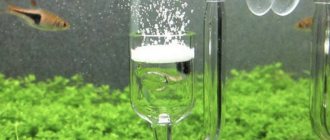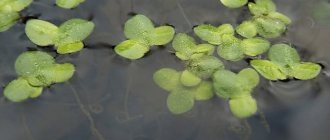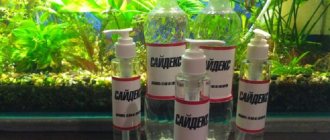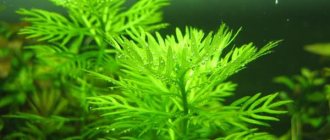Fish and other creatures living in aquariums are able to feed not only on the food that the owner buys and pours into the water, but also on the flora growing in the aquarium. To prevent such plants from withering, they also need to eat something. The optimal solution for this is carbon dioxide, which is dissolved in water. But in a confined space, water quickly loses it. Therefore, it makes sense to make a CO2 generator for an aquarium with your own hands.
Some aquarium plants need carbon dioxide, which is dissolved in the water.
Supplying carbon dioxide with sparkling water
Many aquarists, thinking about such a question as a DIY system for supplying CO2 to an aquarium, do not even realize that the problem can be solved in a very simple way - carbonated mineral water. Bottles of mineral water with gas contain a significant amount of carbon dioxide - up to 10,000 mg/l. Even taking into account that after opening the container most of the gas disappears instantly, a decent portion of CO2 still remains in sparkling water - 1500 mg/l.
It should be immediately noted that the DIY method of supplying CO2 using sparkling water is only suitable for those tanks whose capacity does not exceed 50 liters. To introduce carbon dioxide, you just need to pour carbonated water into the pond every morning at the rate of 20 mm/10 liters of liquid. This amount will be enough for the representatives of the flora, and soon the green inhabitants will say “thank you” to the owner, demonstrating a blooming and healthy appearance.
What should oil workers do?
According to a report by scientists from the St. Petersburg Mining University, CCS is simply a link in the transition from hydrocarbons to renewable energy sources. It is not an alternative to oil and gas, like hydrogen or the cap-and-trade market.
Therefore, there is no need to be afraid of new technologies in the oil industry. Sequestration will not bring the same profits and will not leave industry employees without jobs. Perhaps there will even be more of it, notes vice-president of the Independent Fuel Union Dmitry Gusev : “If we extract oil and gas and pump CO2 into it, then the same oil workers will do this at the field - on the contrary, they will have more work.”
Making a mast
If the antenna is at home, it is often attached to the handles that open the windows/vents with a hanger hook. Then the mast is not needed. When installing outdoors, you need to build a mast - a long holder, which will also be attached either to the wall or to the lid. May be:
- wooden;
- metal;
- plastic.
The most common ones are made of wood and metal.
The assembled antenna is mounted at the top of any mast. Fastening bolts and wires should not come into contact with elements of the device itself.
When the antenna is the highest point of a building, for example, a private house, it is better to make a lightning outlet just in case.
See examples of fastenings in the gallery below.
What is carbon dioxide storage?
The official name of the technology is carbon dioxide sequestration (CCS). This is the name for the process of collecting, transporting and storing CO2. Special systems capture gas released during production. It is then pumped into depleted oil and gas fields, coal seams or salt formations.
According to the report, CCS is used in Norway, the USA, the Netherlands and Australia. But in Russia there has never been such an experience. So far, the idea to develop the technology at the conference of producers and consumers of liquefied natural gas LNG Producer-Consumer Conference 2020 was only announced by the head of NOVATEK Leonid Mikhelson .
Industrial Applications
The use of carbon dioxide in various fields of industry is associated with the chemical and physical properties of the substance. It does not burn, is not dangerous in minimal concentrations for humans and animals, and is the main component for plant life.
Chemical industry:
- Participates in the synthesis of artificial chemicals;
- Regulates temperature in reactions;
- Neutralizes alkalis;
- Cleans animal and plant tissues;
- Can be reduced to methane.
Metallurgy:
- Exhaust smoke deposition;
- Regulates the direction of water flow when draining mines;
- Some lasers use CO2 as their energy source (neon).
Paper production:
- Regulates the pH value in wood pulp or cellulose;
- Increases the power of production machines.
Dry ice plays a special role in industrial and related industries. It is applied as:
- Source of cooling in freezers during transportation;
- Cooling during solidification of alloys;
- Cleaning equipment with dry ice (cryoblasting).
Amplifier installation
You can try to upgrade the antenna so that it receives signals from more distant towers by connecting an antenna amplifier. This will not make the design any more complicated.
- Connect the cable to the amplifier board.
- Screw the tabs with bolts and nuts to the board.
- Unscrew the plug box of the amplifier unit. Strip the cable at the free end and secure it to the board with the already built-in bolt mounts.
- Hang the antenna close to the window. Insert the plug into the antenna socket of the TV. Plug the power supply into a power outlet. Try setting up channels, check the signal quality.
Four-tank antenna
May be suitable for long-distance reception.
If the terrain does not block the signal, then the canned 4-capacitor version can catch waves up to 50 km. This is very suitable for dachas and country houses.
The design differs in the connection diagram of the cans and design calculations. It is necessary to maintain the correct cross-section of the connecting wires and the distance between them.
- Mark a board of sufficient size and lay aluminum conductors bent at both ends at right angles. Strip the insulation in the center of the wires to connect to the cable directly or to the connector into which the cable will be plugged.
- Drill 3 holes for each conductor in the center of the board. Two holes are needed for a piece of wire to secure the 300/75 transformer to the back of the board. One hole is used to press and connect all the conductors (a screw is used).
- Make a hole in the side of the top of the jar with a knife. Screw a self-tapping screw through the hole in the same place, only on the other side. From the outside, sand the area with sandpaper, removing the excess layer.
- Using self-tapping screws, without removing it from the can, secure it to the plywood, connecting it in parallel with the wires.
- The next step is to prepare the wire to secure the transformer. The wire is threaded through the holes and secured with screws to the transformer body.
- Finally, the conductors that connect the cans need to be fixed to the plywood. A self-tapping screw is screwed into the central hole. It simultaneously secures and connects the conductors.
- The resulting antenna remains to be connected to the TV. Both cable ends are equipped with a plug. One is inserted into the television socket, the other is connected to the transformer.
It is recommended to install the antenna in conditions not exposed to atmospheric phenomena: strong wind, precipitation. The antenna is highly susceptible to wind, the position of the cans may change, which affects reception.
A more durable fastening is a wooden mast with parallel cross bars.
Why does Russia need CCS?
Let us remind you that the European Union is preparing to implement the “Green Deal” - a global project that should completely stop industrial emissions of greenhouse gases by 2050 in Europe and transfer it to renewable energy sources.
Photo: Pixabay
Scientists from St. Petersburg Mining University believe that CCS can ensure a smooth transition from the old paradigm to the new one. This is beneficial to the EU, as it allows it to reduce greenhouse gas emissions without a sharp abandonment of hydrocarbons, and to Russia, which can maintain the existing energy system longer and earn money on the supply of hydrocarbons to Europe.
“The Europeans talk about their new environmental policy, but we supply hydrocarbons there - and therefore we cannot ignore them. Therefore, Russia has to come up with some moves. And capturing greenhouse gases is a good response,” Konstantin Simonov .
Making your own CO2 generator
To provide plants with carbon dioxide, you can purchase a CO2 reactor in specialized stores, but such an installation is huge in size and is not cheap. Experienced aquarists prefer to use homemade products - a CO2 generator made independently from scrap materials.
In terms of effectiveness, a homemade unit is not inferior to store-bought analogues, and assembling and installing a CO2 device in an aquarium will not take much time, money and effort of the owner.
Materials for production
To build a CO2 generator with your own hands you will need:
- Transparent plastic bottle with a capacity of 2 l – 1 pc.
- Plastic empty bottle with a wide neck – 1 pc.
- Medical syringe – 1 pc.
- Dropper tube – 1 pc.
- Silicone.
- Back pressure valve – 1 pc.
- Hose – 1 pc.
- Suction cups for fixation.
- Spray.
Assembly
Having prepared the necessary materials, the CO2 system for the aquarium is assembled as follows:
- The piston is removed from the medical syringe and the lower part is cut off, placing a back pressure valve in the syringe.
- Remove partitions and excess protrusions from the bottle cap using a sharp knife. During the operation, be careful not to get hurt.
- The prepared syringe with a valve is connected to the cap using aquarium silicone. A little water is poured into the resulting structure - the device will play the role of a CO2 bubble counter with your own hands.
- The completed counter is connected to a large plastic bottle.
- Holes for the adapter are made in the cap of the second bottle using a thick needle. The adapter from the dropper is inserted into the lid and the hose is connected. The joints are coated with silicone.
- The resulting CO2 generator is filled with liquid. The structures are connected with hoses: from a bottle with a capacity of 2 liters, the tip of the tube is attached to the valve cover, from a needle - to an artificial reservoir.
Compositions for the generator
Having assembled a homemade generator to supply CO2 to the aquarium, you should start preparing a solution that will release carbon dioxide through fermentation. There are many recipes for releasing carbon dioxide, but the most popular and simplest are:
- With soda and food - for preparation you will need 200 g of granulated sugar, a pinch of soda, ½ teaspoon of fish food, yeast and a piece of bread. The ingredients are poured into the bottle, and the mixture is filled with warm water, leaving five cm from the lid. After this, the sprayer of the homemade generator is lowered into the tank and after 10 hours the carbon dioxide supply is checked. If CO2 is not released, then there are leaky places in the structure. An aquarium wash made according to this recipe will release CO2 for two weeks, after which you need to prepare a fresh solution.
- With starch - the aquarist will need 400 g of granulated sugar, 140 g of baking soda, 160 g of starch and 1 liter of water. The ingredients are placed in a saucepan and boiled until thick, then left to cool. The cooled mixture is poured into a fermentation bottle and the sprayer is placed in a pond. Carbon dioxide will be released using this mixture for 3 months.
- With soda and flour - for cooking you need yeast (on the tip of a knife), 100 g of granulated sugar, 25 g of flour and soda. The components are poured into 500 ml of water, mixed thoroughly and poured into a bottle for fermentation. Validity period: 14 days.
- With gelatin - the composition will be valid for 30 days. To prepare, add 30 g of gelatin to 500 ml of water and leave to swell for half an hour. After the specified time has elapsed, add the same amount of water and 1 tbsp to the mixture. spoon of soda. The mixture is placed on low heat until the substances are completely dissolved. After this, the mixture is poured into a fermentation bottle, dry yeast is added and the lid is closed.
- With citric acid - the most popular composition recipe. Citric acid and soda are supplied with CO2 to the aquarium during daylight hours, and it is prepared very simply: you need to add 10 g of citric acid and the same amount of soda, mix and pour into a pre-moistened container. The supply of CO2 to the aquarium with citric acid and soda is ready.
Application in other fields of activity
People also use carbon dioxide in other areas of activity and in everyday life. The availability of dioxide makes it widespread, and its properties make it in demand even among ordinary people.
Carbon dioxide application scheme
Where else is carbon dioxide used:
- When welding. Protects the metal from heating and oxidation by flowing around the electric arc.
- In agriculture. Carbon dioxide coupled with sunlight is an ideal way to fertilize any crop. Spraying gas in a greenhouse or greenhouse increases productivity by 2-3 times;
- In medicine, it is used to create an atmosphere close to the real one when performing artificial operations on organs. It is used as a stimulant to restore the patient’s breathing and when inducing him into anesthesia;
- Pharmaceuticals. Creates an ideal environment for chemical synthesis and low-temperature water transportation;
- Instruments and equipment. Cools equipment and units without disassembling them into modules, acts as an abrasive cleaning element;
- Environment protection. Regulates the hydrogen level in waste water;
- Food industry. Used as a preservative and leavening agent for dough. Added to drinks, making them carbonated;
- To create pressure in air guns.
The use of carbon dioxide is especially in demand in fire extinguishing systems. It is filled into carbon dioxide gas fire extinguishers and, in the event of a fire, allows the fire to be isolated from the source of oxygen. Combustion cannot continue for long without air supply, and gasification with carbon dioxide will not allow it to penetrate the fire.
Obtained in small quantities from alcoholic fermentation, it is used as a way to carbonate drinks. It also protects flour, dried fruits, and peanuts from insects without affecting the quality and speed of their spoilage.
Carbon dioxide is a first-class medium for growing flowers, feeding vegetables and underwater plants. It accelerates photosynthesis and improves metabolic processes in plant cells. The main thing is that it has an affordable price even for ordinary people.
Carbon dioxide can also be used in cryodestruction, as a freezing agent. It burns the surface of warts and moles with cold, causing them to fall off, but not leaving scars from a scalpel and stitches.
How to bury gas?
Once captured, CO2 is transported to a disposal site. Two methods are used for this - pipelines and ships, including tankers carrying liquefied natural gas (LNG). St. Petersburg scientists believe the second option is more effective: tankers are more flexible in terms of logistics and can adapt to different gas storage conditions. In addition, their use will help save on infrastructure development - there is no need to build an expensive network.
The authors of the report believe that the most attractive option for Russia is to place gas in depleted oil fields. This is because CO2, supplied into the well under very high pressure, mixes with the remaining oil, increasing its volume and reducing viscosity. Thanks to this, oil workers can extract more resources.
Infographics: St. Petersburg Mining University
Installation
- Install the mast with the antenna already attached to it on the most suitable base - a wall, a roof.
- The device must first be rotating in a horizontal plane. Rotation along the axis will help you most accurately determine the directionality for the best signal. The conclusion is made based on the result shown by the scale on the TV screen. All modern receivers and TVs with digital support have this function.
- Once the position is determined, the structure is securely fixed. Even strong gusts of wind should not change the situation.










